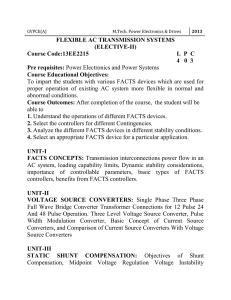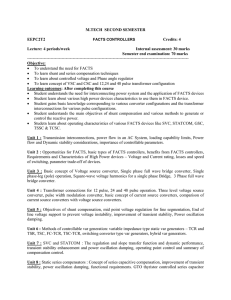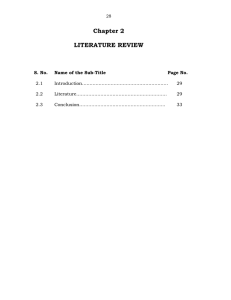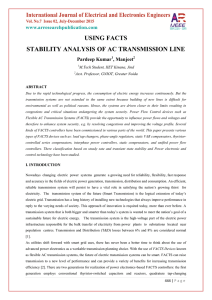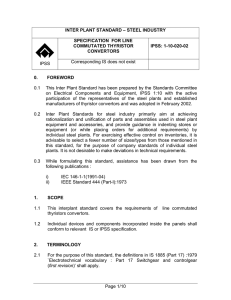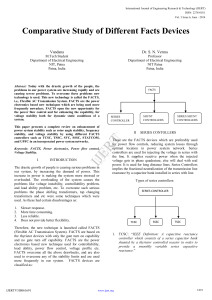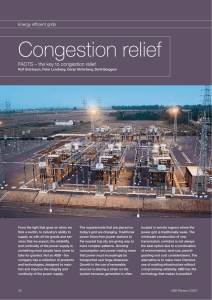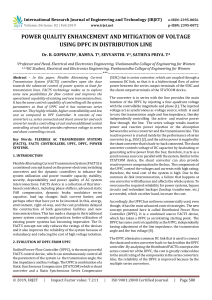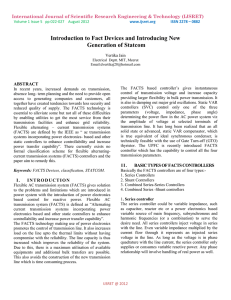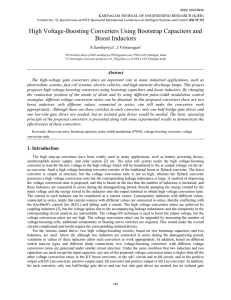Course Title: FACTS Controllers Credit Units: Course Level
advertisement
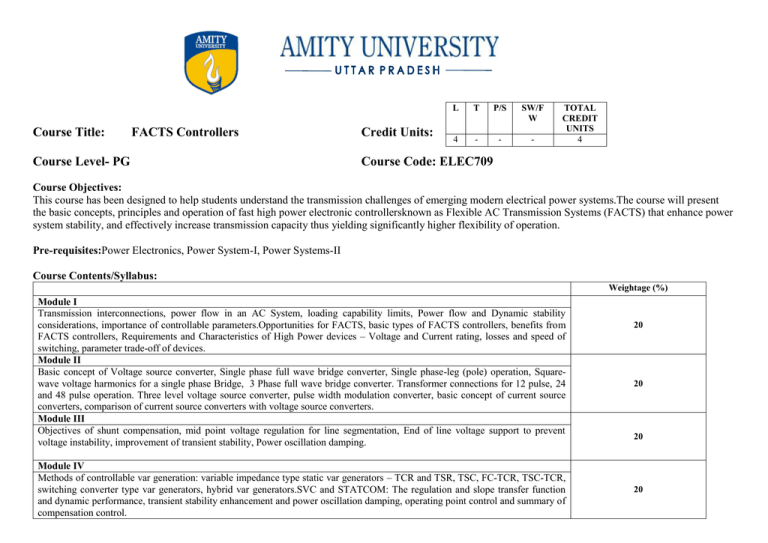
Course Title: FACTS Controllers Course Level- PG Credit Units: L T P/S SW/F W 4 - - - TOTAL CREDIT UNITS 4 Course Code: ELEC709 Course Objectives: This course has been designed to help students understand the transmission challenges of emerging modern electrical power systems.The course will present the basic concepts, principles and operation of fast high power electronic controllersknown as Flexible AC Transmission Systems (FACTS) that enhance power system stability, and effectively increase transmission capacity thus yielding significantly higher flexibility of operation. Pre-requisites:Power Electronics, Power System-I, Power Systems-II Course Contents/Syllabus: Weightage (%) Module I Transmission interconnections, power flow in an AC System, loading capability limits, Power flow and Dynamic stability considerations, importance of controllable parameters.Opportunities for FACTS, basic types of FACTS controllers, benefits from FACTS controllers, Requirements and Characteristics of High Power devices – Voltage and Current rating, losses and speed of switching, parameter trade-off of devices. Module II Basic concept of Voltage source converter, Single phase full wave bridge converter, Single phase-leg (pole) operation, Squarewave voltage harmonics for a single phase Bridge, 3 Phase full wave bridge converter. Transformer connections for 12 pulse, 24 and 48 pulse operation. Three level voltage source converter, pulse width modulation converter, basic concept of current source converters, comparison of current source converters with voltage source converters. Module III Objectives of shunt compensation, mid point voltage regulation for line segmentation, End of line voltage support to prevent voltage instability, improvement of transient stability, Power oscillation damping. Module IV Methods of controllable var generation: variable impedance type static var generators – TCR and TSR, TSC, FC-TCR, TSC-TCR, switching converter type var generators, hybrid var generators.SVC and STATCOM: The regulation and slope transfer function and dynamic performance, transient stability enhancement and power oscillation damping, operating point control and summary of compensation control. 20 20 20 20 Module V Static series compensators: Concept of series capacitive compensation, improvement of transient stability, power oscillation damping, functional requirements. GTO thyristor controlled series capacitor (GSC), thyristor switched series capacitor (TSSC), and thyristor controlled series capacitor (TCSC), control schemes for GSC, TSSC and TCSC. 20 Student Learning Outcomes: After completion of this course students will be able 1. Introduce the operating principles, control systems and modeling of different FACTS Controllers 2. Understand the influence of measurement systems, network resonances and harmonic interactions onthe performance of FACTS control systems 3. Provide the techniques of FACTS controller design for enhancing power transfer, stability anddamping, mitigating sub-synchronous resonances, preventing voltage instability, etc. 4. Understand the interactions amongst various FACTS Controllers and techniques for theircoordination and placement. Pedagogy for Course Delivery: Class Room Lectures, assignments, Quizes Assessment/ Examination Scheme: Theory L/T (%) Lab/Practical/Studio (%) Total 100 - 100 Theory Assessment (L&T): Continuous Assessment/Internal Assessment End Term Examination Components (Drop down) A CT S/V/Q HA EE Weightage (%) 5 10 8 7 70 Text & References: Text: “Understanding FACTS” N.G. Hingorani and L.Guygi, IEEE Press. References: Indian Edition is available:--Standard Publications, 2001. “Flexible a c transmission system (FACTS)” Edited by YONG HUE SONG and LLAN T JOHNS, Institution of Electrical Engineers, London. R.M. Mathur and R.K. Varma, “Thyristor-Based FACTS Controllers for Electrical TransmissionSystems”, IEEE Press and John Wiley & Sons, New York, USA, Feb. 2002
